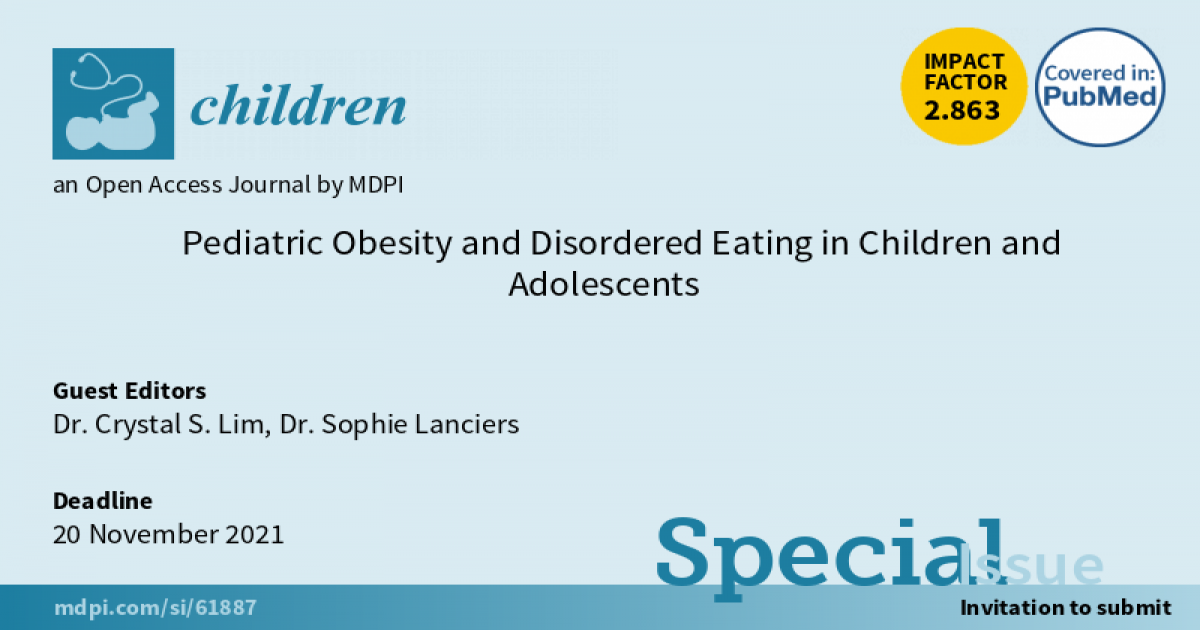Pediatric Obesity and Disordered Eating in Children and Adolescents
A special issue of Children (ISSN 2227-9067). This special issue belongs to the section "Global Pediatric Health".
Deadline for manuscript submissions: closed (5 November 2022) | Viewed by 13088

Special Issue Editors
Interests: pediatric obesity and weight management treatments; psychological comorbidities associated with pediatric obesity; disordered eating; behavioral family weight management interventions; telehealth pediatric weight management interventions; health disparities and cultural and community factors
Interests: pediatric obesity, assessment, and medical weight management; the role of bariatric surgery in pediatrics; building a successful multidisciplinary family-oriented pediatric obesity program including telehealth and remote access
Special Issue Information
Dear Colleagues,
Pediatric obesity continues to be a critical public health issue due to its high prevalence and medical and psychological impacts. Despite great strides in the prevention and treatment of pediatric obesity, there continues to be high rates of overweight and obesity in youth. In addition, disordered eating in youth has increased in prevalence in recent decades, and is associated with short- and long-term consequences. Pediatric obesity or disordered eating put youth at risk for a number of physical and psychological comorbidities.
The goal of this Special Issue in Children is to highlight recent scientific advances examining associations between pediatric obesity and/or disordered eating in children and adolescents, as well as advances in treatment approaches for pediatric obesity or disordered eating in youth. We invite manuscripts focused on young children through emerging adults, and both healthy groups as well as samples that are overweight/obese. We welcome reviews and original research focused on novel interventions, as well as those that identify gaps in knowledge. Submissions that focus on key outcomes related to pediatric obesity and disordered eating, such as weight status, dietary intake, and eating behaviors are also welcome, as are process evaluations that describe the development of approaches that will advance the treatment of pediatric obesity and/or disordered eating.
Dr. Crystal S. Lim
Dr. Sophie Lanciers
Guest Editors
Manuscript Submission Information
Manuscripts should be submitted online at www.mdpi.com by registering and logging in to this website. Once you are registered, click here to go to the submission form. Manuscripts can be submitted until the deadline. All submissions that pass pre-check are peer-reviewed. Accepted papers will be published continuously in the journal (as soon as accepted) and will be listed together on the special issue website. Research articles, review articles as well as short communications are invited. For planned papers, a title and short abstract (about 100 words) can be sent to the Editorial Office for announcement on this website.
Submitted manuscripts should not have been published previously, nor be under consideration for publication elsewhere (except conference proceedings papers). All manuscripts are thoroughly refereed through a single-blind peer-review process. A guide for authors and other relevant information for submission of manuscripts is available on the Instructions for Authors page. Children is an international peer-reviewed open access monthly journal published by MDPI.
Please visit the Instructions for Authors page before submitting a manuscript. The Article Processing Charge (APC) for publication in this open access journal is 2400 CHF (Swiss Francs). Submitted papers should be well formatted and use good English. Authors may use MDPI's English editing service prior to publication or during author revisions.
Keywords
- pediatric obesity
- disordered eating
- youth
- young children
- adolescents
- prevention and interventions
- treatment approaches
Benefits of Publishing in a Special Issue
- Ease of navigation: Grouping papers by topic helps scholars navigate broad scope journals more efficiently.
- Greater discoverability: Special Issues support the reach and impact of scientific research. Articles in Special Issues are more discoverable and cited more frequently.
- Expansion of research network: Special Issues facilitate connections among authors, fostering scientific collaborations.
- External promotion: Articles in Special Issues are often promoted through the journal's social media, increasing their visibility.
- e-Book format: Special Issues with more than 10 articles can be published as dedicated e-books, ensuring wide and rapid dissemination.
Further information on MDPI's Special Issue policies can be found here.






